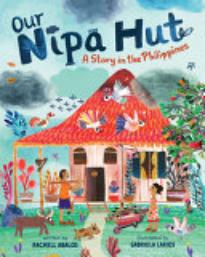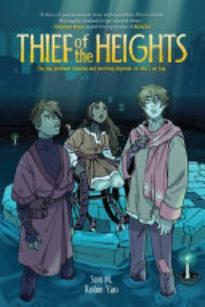Prosthesis
10 Reviews
(2)
K-3
Illustrated by
Gabriela Larios.
"The nipa hut is family too." Yelena Mendoza lives in a traditional nipa hut in the Philippines with her family. Made from palm leaves and bamboo, the structure has stood for many generations, lovingly cared for and repaired by its inhabitants when it needs "a change of clothes." During a big storm, the nipa hut "sways," "shakes," and "flinches." A gust of wind pushes the windows open, bringing in rain and cold; are "Yelena and the nipa hut...no match for the storm"? With Papa's help, they make it through -- though afterward the nipa hut is in need of repairs. "'You will be okay,' [Yelena] says. 'Thank you for taking care of us.'" Abalos's warm text is true to a child's perspective; Larios's color-saturated illustrations, teeming with wildlife and plants native to the Philippines, have a compellingly naif quality. Details in the art enhance the story: Papa has a prosthetic leg; a framed portrait on the wall might be Yelena and baby brother Marco's mother, whom the story doesn't mention. An author's note dives deeper into the history and architectural influence of the nipa hut (its structural flexibility inspired the first skyscraper), the Philippines, and climate change and includes a glossary of Tagalog words.
Reviewer: Gabi K. Huesca
| Horn Book Magazine Issue:
July, 2024
(2)
YA
Illustrated by
Robin Yao.
In the distant dystopian-future setting of this graphic novel towers the monumental stacked city of Muqadas, where each level dictates the quality of life of its citizens. A trio of adolescent friends -- Basem, Mustafa, and Aarfah -- resides in the lower region of Saha, a tier plagued by a water-polluting virus that infects the limbs and must ultimately be treated by amputation. Using their engineering skills, Basem and Mustafa generate prosthetic legs from scrap metal for Aarfah. Their ingenious efforts attract a scout from the tiers above, granting them an opportunity for social mobility and a chance at a new life. But what must they compromise to achieve this status? A story of class divisions, exploitation, and marginalization unfolds in this segmented world that mirrors real-world health inequities and socioeconomic injustices. The forest greens and indigo blues punctuated by glowing candlelight in the lower tiers clash with the pastel-hued opulence of the upper regions, symbolizing the disconnect and social disparity between the tiers. Dynamic characterization and atmospheric world-building in a setting with echoes of contemporary Muslim society engender a fantastically allegorized tale touching on themes of social stratification, solidarity, friendship, queer relationships, survival, and hope in a world fractured by enduring class struggles.
Reviewer: Jerry Dear
| Horn Book Magazine Issue:
January, 2025
(3)
4-6
Animal-rescue stories are always popular; this book enhances the topic by delving into how prosthetics dramatically improved the lives of five animals. The gravely injured subjects--a Kemp's ridley sea turtle, an Asian elephant, a German shepherd, a goose, and a pig--were rehabilitated thanks to the compassion, perseverance, and collaboration of teams of rescuers and researchers. Each affecting story includes captioned photos of the animal subjects and their human caregivers. A related activity follows each story, helping readers better understand animal body mechanics and scientists' creative problem-solving methods. A glossary, selected bibliography, related organizations, and index are appended.
Reviewer: Kitty Flynn
(2)
K-3
Encounter series.
Illustrated by
Harriet Popham.
Karl, an Abyssinian ground hornbill, arrived at the Smithsonian's National Zoo with a damaged lower bill, which limited his ability to eat a balanced diet and participate in normal activities. Nargi's lighthearted and informative account shows how zoo staff engineered Karl a 3-D printed beak, each step in the process demonstrating how engineering and science can solve problems in animal conservation. Creative illustrations combine blueprint-like schematics with photos; a downloadable companion app is available. Glos.
Reviewer: Danielle J. Ford
| Horn Book Magazine Issue:
May, 2019
(2)
K-3
Illustrated by
Scott Magoon.
Disappointed Rescue becomes a service dog rather than a seeing eye dog; meanwhile, human Jessica learns her leg has been amputated. Brought together, they form a powerful, caring bond working as a team. Based on a true story, the quiet and stirring text pairs beautifully with the spot art and full-page illustrations, which use color and white space to convey time, meaning, and emotion with great effect.
Reviewer: Julie Roach
| Horn Book Magazine Issue:
March, 2018
(4)
YA
Maisie McCall is lonely when she first leaves home to harvest much-needed timber for the war effort in Scotland's Women's Timber Corps. Soon she's made as many friends as she has calluses on her hands--and she's fallen in love with a wounded Canadian soldier. Leech's somewhat slow fictionalized account of Scottish "lumberjills" during WWII also explores the complexity of forming a relationship with someone coming to terms with a disability.
Reviewer: Lisa Catherine Findlay
(3)
4-6
Wild and domestic animals, including a goat, an elephant, and an alligator, are each given a new lease on life through innovative wheelchairs or prosthetic body parts. The volume also profiles the devices' creators and discusses how the inventions help humans as well. Although there's a certain repetition to the stories, they're engaging and inspiring, illustrated with plenty of appealing photos. Websites. Bib., glos., ind.
Reviewer: Janet Dawson
(3)
YA
Isolated by guilt and anxiety since her sister's death, Vancouver sixteen-year-old Petula De Wilde finds YART (mandatory Youth Art Therapy) utterly useless--until newcomer Jacob Cohen, who has a prosthetic arm, unites YART's attendees. But there's a secret behind Jacob's own guilt. Well-drawn characters and nuanced representation of life with an anxiety disorder keep a familiar plot from feeling predictable.
Reviewer: Rebecca Fox
(4)
4-6
Searchlight Books: What's Cool About Science? series.
These slight volumes describe breakthrough medical technologies and procedures, including the preservation of living tissue via cooling and freezing; innovations in the replacement of limbs and organs; and developments such as virtual doctors and health trackers. The coverage is cursory, but it's interesting and well organized. Captioned photographs and sidebars are well integrated into the main text. Reading list, websites. Glos., ind. Review covers the following Searchlight Books: What's Cool About Science? titles: Discover Cryobiology, Discover Bionics, and Discover Cutting-Edge Medicine.
Reviewer: Danielle J. Ford
(4)
YA
Mira has it all: she's a rock band singer and a lacrosse star, and her grades are almost perfect. But then a horrible car accident leaves Mira missing two limbs and her future plans. Doctors offer increasingly experimental surgeries and prosthetics until Mira starts to question her humanity. Weyn's science is more magical than believable, but this quick read offers a satisfying ending.
Reviewer: Jenn Matters
10 reviews
We are currently offering this content for free. Sign up now to activate your personal profile, where you can save articles for future viewing.













